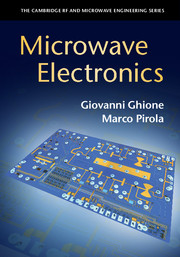Book contents
- Frontmatter
- Dedication
- Contents
- Preface
- Notation and Symbols
- 1 A System Introduction to Microwave Electronics
- 2 Passive Elements and Circuit Layout
- 3 CAD Techniques
- 4 Directional Couplers and Power Dividers
- 5 Active RF and Microwave Semiconductor Devices
- 6 Microwave Linear Amplifiers
- 7 Low-Noise Amplifier Design
- 8 Power Amplifiers
- 9 Microwave Measurements
- 10 CAD Projects
- Index
Preface
Published online by Cambridge University Press: 10 November 2017
- Frontmatter
- Dedication
- Contents
- Preface
- Notation and Symbols
- 1 A System Introduction to Microwave Electronics
- 2 Passive Elements and Circuit Layout
- 3 CAD Techniques
- 4 Directional Couplers and Power Dividers
- 5 Active RF and Microwave Semiconductor Devices
- 6 Microwave Linear Amplifiers
- 7 Low-Noise Amplifier Design
- 8 Power Amplifiers
- 9 Microwave Measurements
- 10 CAD Projects
- Index
Summary
Microwave and millimeter-wave electronics is today far more widespread than it used to be only 20 years ago. Traditional applications based on metal waveguide approaches are still on the market (think about radar systems and some satellite-based systems); however, the introduction of solid-state hybrid and above all monolithic microwave integrated circuits (MMICs) using III-V semiconductors such as gallium arsenide, initially in the low microwave range but now covering frequencies up to millimeter waves, has allowed for a dramatic reduction in the size, weight and cost of many microwave systems in fields ranging from wireless telecommunications to space applications to automotive radars.
Starting from the beginning of this century, a new revolution has taken place in MMICs, with the introduction of RF, microwave and now also mm-wave silicon-based ICs (CMOS but also SiGe). This has finally marked the entrance of microwave systems in the area of low-cost consumer electronics. At the same time, new semiconductor materials for high-power applications (such as gallium nitride) are gradually entering the market of microwave systems, with a promise of size and cost reduction related to the record power densities achievable. And yet, despite the widespread conversion to solid-state electronics, in some areas vacuum tubes are still successfully surviving and expanding their potential, e.g., in the field of THz sources.
The design of microwave circuits is largely based today on Computer-Aided Design (CAD) techniques that have turned the “black magic” associated with the design of distributed (transmission line or waveguide) circuits into a routine that is easily manageable by the designer – of course, provided that he or she has well understood the basics of microwave electronics. Alternative approaches based on lumped parameter components, which make the design of microwave integrated circuits quite similar to that of analog integrated circuits at large, have indeed become increasingly popular in MMICs, at least up to the middle microwave range. On the other hand, high-frequency monolithic and hybrid ICs still have to partly rely on distributed components and the related design styles. In conclusion, today's microwave design is a well-balanced blend of distributed and lumped technological approaches that the designer should be able to master.
- Type
- Chapter
- Information
- Microwave Electronics , pp. xv - xviiiPublisher: Cambridge University PressPrint publication year: 2017



